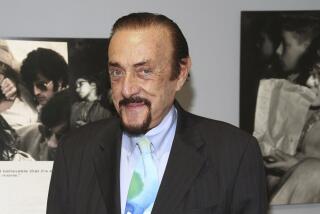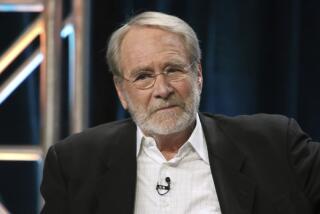Sundance 2015: Michael Almereyda’s ‘Experimenter’ slyly delivers jolts

PARK CITY, Utah — Though they took place more than 50 years ago, the obedience experiments of renowned social psychologist Stanley Milgram have not lost their power to provoke and disturb. But when writer-director Michael Almereyda set out to examine the man and his work, something very different was on his mind.
“I wanted the film to be very playful, because that was part of Milgram’s character,” the director says of his sly and thoughtful film “Experimenter,” which was shown in Sundance’s premieres section and stars Peter Sarsgaard as Milgram and Winona Ryder as his wife. “I wanted the kind of movie he would have made himself.”
Certainly Milgram’s 1961 experiment would not seem to lend itself to a playful approach. Demonstrating how powerless people can be in the face of authority, Milgram told his subjects that they absolutely had to administer electric shocks to other people, shocks that were imaginary but that the subjects thought were causing intense, perhaps irreparable, pain and suffering. Despite this, 65% ended up administering the shocks.
But as a director whose work includes the vampire-themed “Nadja” and a widely admired New York-based “Hamlet” starring Ethan Hawke, Almereyda has shown a gift for subverting genre and overturning expectations, and he elegantly does that here, making a self-aware film that appears to be straight-ahead until it’s not.
A key scene in that transformation has to do with one of the subtexts of Milgram’s experiment: its connection with the Germans who obeyed orders during the Holocaust — something the Jewish scientist referenced in an early interview with the New York Times.
That often unspoken link was the elephant in the room in discussions of the obedience research, which “Experimenter” illustrates by having an actual elephant walk behind Sarsgaard as he breaks the fourth wall and talks to the audience.
“I made an earlier movie with an elephant [1992’s “Another Girl Another Planet”], and since then I’ve always wanted to work with an elephant again,” Almeredya says. “This one was named Minnie, and she was 43 year old, which was also Peter’s age. People brought their children. Everyone gets very happy when there is an elephant on the set.”
Almereyda pinpoints the elephant’s appearance as a key transition point. “You think the movie is Clark Kent, and at that moment it rips its shirt off and becomes Superman,” he says. “It becomes freer. Looser ideas of reality prevail.”
The director had known vaguely about Milgram’s work, but his interest in the scientist increased when a girlfriend took a course on him and Almereyda ended up reading Milgram’s 1975 National Book Award-nominated “Obedience to Authority: An Experimental View.”
“The experiment’s transcripts are quoted at length, and I instantly saw how filmable it was, as well as how intricate, how clever, how deeply researched the experiments were,” he says. “The more I learned, the more convinced I became that this was a movie worth making.”
Plus, as it turned out, Milgram had filmed some of the experiments. “He had some leftover grant money, and over the last two days he filmed the actual subjects through a one-way mirror and turned it into an hourlong film called ‘Obedience,’” Almereyda says. “That was our Grail. We meticulously copied the set design, the uniforms, everything we could.”
Though Milgram’s experiment is more than half a century old, Almereyda was interested in it because “the questions he asked seemed very contemporary. It’s an unfortunate fact that they’re always going to trigger a sense of relevance.
“An introduction to a 1970s edition of the book included several pages on the My Lai massacre [in Vietnam], and today’s moral vacuum around torture and surveillance is clearly addressed. We want to believe we’re brave and compassionate, but sometimes situations tip us in the other direction. The truth about human nature is that people want to resist but don’t.”
Because of the controversial nature of these findings, and the subterfuge involved in the experiment itself, Milgram was severely criticized in his day. “Because he challenged the foundation of our sense of well-being there was real venom and hostility,” Almereyda says. “People felt threatened.”
Because of that, “there is an ongoing controversy, people are constantly trying to debunk him. I think there was a value in what Milgram did. He was a noble and in some way heroic character, and I’d be happy if my film sparks more affection and awareness about him.”
And one more thing. “I hope,” the director says, “it’s light on its feet.”
Twitter: @KennethTuran
More to Read
Only good movies
Get the Indie Focus newsletter, Mark Olsen's weekly guide to the world of cinema.
You may occasionally receive promotional content from the Los Angeles Times.











